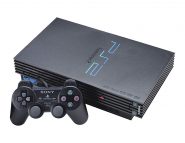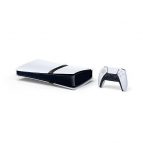![Best Selling Sony Consoles [2024] Best Selling Sony Consoles [2024]](https://data40.com/wp-content/uploads/2024/12/134_header.png)
Sony has long been a powerhouse in the gaming industry, crafting consoles that have not only pushed technological boundaries but also captured the hearts of gamers worldwide. With each generation, Sony has introduced systems that set new standards for gaming experiences and sales records.
| Name | Developers | Manufacturers | Release Date | Hardware Sales | Software Sales |
|---|---|---|---|---|---|
 | Sony Computer Entertainment | Sony Electronics, Foxconn | Japan: March 4, 2000, North America: October 26, 2000, Europe: November 24, 2000 | Over 160 million units | Over 1.5 billion units |
 | Sony Interactive Entertainment | Sony Electronics, Foxconn | Japan: February 22, 2014; North America: November 15, 2013; Europe: November 29, 2013 | Approximately 117 million units | Over 1.5 billion units |
 | Sony Computer Entertainment | Sony Electronics | Japan: December 3, 1994; North America: September 9, 1995; Europe: September 29, 1995 | Approximately 102.4 million units | Over 962 million units |
 | Sony Computer Entertainment | Sony, Foxconn, Asus | Japan: November 11, 2006; North America: November 17, 2006; Europe: March 23, 2007 | Approximately 87.4 million units | Over 999 million units |
 | Sony Computer Entertainment | Sony Electronics | Japan: December 12, 2004; North America: March 24, 2005; Europe: September 1, 2005 | Over 76 million units | Over 330 million units |
 | Sony Interactive Entertainment | Sony, Foxconn | November 12, 2020 | Over 65 million units | 53.6 million units |
In this article, we explore the Best Selling Sony Consoles of 2024, highlighting the iconic systems that have achieved phenomenal success. From groundbreaking features to unforgettable game libraries, these consoles showcase why Sony remains a dominant force in the gaming world. Let’s dive into the legacy and impact of these best-sellers!
Best Sellers
![Best Selling Sony Consoles [2024]](https://data40.com/wp-content/uploads/2024/12/134-diagram.png)
1. PlayStation 2 (PS2)

- Developers: Sony Computer Entertainment, with notable contributions from Ken Kutaragi, often referred to as the “Father of the PlayStation.”
- Manufacturers: Sony Electronics, Foxconn
- Release Date:
- Japan: March 4, 2000
- North America: October 26, 2000
- Europe: November 24, 2000
- Hardware Sales: Over 160 million units (worldwide)
- Software Sales: Over 1.5 billion units (worldwide)
The PlayStation 2 (PS2) is the best-selling gaming console of all time. It introduced DVD playback, which significantly contributed to its widespread adoption during the early 2000s. The PS2 featured backward compatibility with original PlayStation games, a vast library of over 4,000 titles, and support for innovative peripherals like the EyeToy and network adapter for online gaming. Iconic titles such as Grand Theft Auto: San Andreas, Final Fantasy X, Metal Gear Solid 2, and God of War established the PS2 as a powerhouse for both casual and hardcore gamers.
The PlayStation 2’s success is a masterclass in multi-functional product positioning. Sony’s decision to integrate DVD playback turned the PS2 into a cost-effective entertainment system, appealing to non-gamers and gamers alike. Its marketing campaigns emphasized value, versatility, and a superior game library, while partnerships with third-party developers ensured a steady stream of exclusive and blockbuster titles. For marketers, the PS2 demonstrates how expanding a product’s utility beyond its core purpose can drive adoption and how fostering robust third-party support can create long-term ecosystem success.
2. PlayStation 4 (PS4)

- Developers: Sony Interactive Entertainment
- Manufacturers: Sony Electronics, Foxconn
- Release Date:
- Japan: February 22, 2014
- North America: November 15, 2013
- Europe: November 29, 2013
- Hardware Sales: Approximately 117 million units (worldwide)
- Software Sales: Over 1.5 billion units (worldwide)
The PlayStation®4 (PS4) is a home gaming console that emphasized powerful hardware, online connectivity, and immersive gameplay experiences. Its AMD-powered architecture made game development easier, resulting in an extensive library of critically acclaimed games, including The Last of Us Part II, God of War, Horizon Zero Dawn, and Uncharted 4. The PS4 introduced the DualShock 4 controller, featuring a touchpad and enhanced motion controls, as well as support for virtual reality with the PlayStation VR headset. The console focused heavily on social connectivity through features like Share Play and game streaming.
The PS4’s success showcases the impact of aligning consumer needs with technological advancements. Sony’s marketing strategy highlighted the console’s superior hardware performance, exclusive game library, and social gaming features, positioning it as a premium yet accessible gaming experience. The emphasis on community engagement, user-friendly design, and robust partnerships with third-party developers further solidified its dominance over competitors. For marketers, the PS4 exemplifies the importance of consistent branding, leveraging exclusive content, and fostering a strong online ecosystem to sustain user engagement and drive adoption.
3. PlayStation (PS1)

- Developers: Sony Computer Entertainment
- Manufacturers: Sony Electronics
- Release Date:
- Japan: December 3, 1994
- North America: September 9, 1995
- Europe: September 29, 1995
- Hardware Sales: Approximately 102.4 million units worldwide
- Software Sales: Over 962 million units worldwide as of March 31, 2012.
The PlayStation introduced 3D polygonal graphics and CD-ROM technology, allowing for larger and more complex games. It featured a vast library of titles across various genres, including iconic games like Final Fantasy VII, Metal Gear Solid, Gran Turismo, and Resident Evil. The console’s design and controller layout became a standard in the industry, influencing future gaming systems.
The PlayStation’s success demonstrated the effectiveness of targeting a broader demographic, including both traditional gamers and a more mature audience. Sony’s marketing strategies emphasized the console’s advanced technology and diverse game library, positioning it as a versatile entertainment system. Collaborations with third-party developers ensured a steady stream of exclusive and high-quality titles, enhancing the console’s appeal. For marketers, the PlayStation exemplifies the importance of understanding consumer desires, leveraging technological innovation, and building strong partnerships to create a compelling product offering.
4. PlayStation 3 (PS3)

- Developers: Sony Computer Entertainment
- Manufacturers: Sony, Foxconn, Asus
- Release Date:
- Japan: November 11, 2006
- North America: November 17, 2006
- Europe: March 23, 2007
- Hardware Sales: Approximately 87.4 million units
- Software Sales: Over 999 million units
The PlayStation 3 (PS3) is a home gaming console that introduced groundbreaking technology, such as Blu-ray disc support, for high-definition gaming and media playback. It featured online connectivity through the PlayStation Network (PSN), allowing for multiplayer gaming, digital downloads, and media streaming. The PS3 boasted a wide array of critically acclaimed games, including The Last of Us, Uncharted 2, God of War III, and Gran Turismo 5. Its unique architecture posed challenges for developers but allowed for advanced graphics and gameplay experiences.
The PS3 faced a rocky start due to its high launch price and complex hardware but recovered through strategic price cuts, a focus on exclusive titles, and the growth of PSN services. Its marketing highlighted the console as an all-in-one entertainment hub, emphasizing Blu-ray capabilities, HD graphics, and access to online media. For marketers, the PS3 serves as a case study in overcoming early challenges through product iteration, aggressive pricing strategies, and leveraging exclusive content to regain market competitiveness.
5. PlayStation Portable (PSP)

- Developers: Sony Computer Entertainment
- Manufacturers: Sony Electronics
- Release Date:
- Japan: December 12, 2004
- North America: March 24, 2005
- Europe: September 1, 2005
- Hardware Sales: Over 76 million units
- Software Sales: Over 330 million units
The PlayStation Portable (PSP) was Sony’s first foray into the handheld gaming market. It featured a large, high-resolution LCD screen, multimedia capabilities, and support for UMD (Universal Media Disc) for games and movies. The PSP delivered console-quality experiences on the go with titles like God of War: Chains of Olympus, Crisis Core: Final Fantasy VII, and Monster Hunter Freedom Unite. It also offered robust multimedia features, including music and video playback, internet browsing, and digital downloads through the PlayStation Store.
The PSP marked a significant step in bringing high-performance gaming to handheld devices, competing directly with the Nintendo DS. Sony’s marketing emphasized multifunctionality, positioning the PSP as an all-in-one entertainment device for gaming, movies, and music. Its sleek design and multimedia capabilities appealed to a broader demographic, including casual gamers and tech enthusiasts. For marketers, the PSP highlights the importance of product differentiation in a competitive market and leveraging multimedia features to appeal to non-gaming audiences. It also demonstrates the value of building a strong software library to support a hardware platform.
6. PlayStation5 (PS5)

- Developers: Sony Interactive Entertainment
- Manufacturers: Sony, Foxconn
- Release Date:
- Worldwide (initial regions): November 12, 2020
- Worldwide (other regions): November 19, 2020
- Hardware Sales: Over 65 million units (worldwide as of December 2023)
- Software Sales: 53.6 million units in Q1 FY2024.
The PlayStation®5 (PS5) is Sony’s most advanced gaming console, featuring a custom AMD processor, ray tracing support, ultra-fast SSD storage, and 4K resolution gaming capabilities. It offers two versions: the Standard Edition with a Blu-ray disc drive and the Digital Edition for download-only content. The console introduced the DualSense controller, which features haptic feedback and adaptive triggers for a more immersive gaming experience. Its growing game library includes critically acclaimed titles like Demon’s Souls, Ratchet & Clank: Rift Apart, Horizon Forbidden West, and Marvel’s Spider-Man 2.
The PS5 exemplifies the power of blending cutting-edge technology with robust marketing strategies. Sony’s campaigns highlighted the console’s power, speed, and innovative controller features, emphasizing its ability to deliver next-generation gaming experiences. For marketers, the PS5 underscores the importance of launching a product with strong branding, a well-communicated value proposition, and a diverse library of exclusive titles. Its dual-version strategy (Standard and Digital Editions) also demonstrates how segmentation can effectively address different market needs.
PlayStation Powerhouses
Sony’s journey in the gaming industry has been marked by consistent innovation and an unwavering focus on delivering unparalleled gaming experiences. The Best Selling Sony Consoles of 2024 not only reflect the company’s ability to adapt to evolving market demands but also highlight its commitment to pushing the boundaries of technology and entertainment. From timeless classics to modern favorites, these consoles have left an indelible mark on gamers worldwide, securing Sony’s position as a leader in the gaming world. As the industry continues to evolve, Sony’s legacy of excellence ensures its consoles will remain at the forefront of gaming for years to come.
Yes, Sony's new CEO, Hideaki Nishino, has confirmed that consoles will remain a key part of the company’s strategy, even as it explores opportunities in PC gaming.
Yes, a more powerful version of the PS5 is set to launch on November 7, 2024. It will feature PSSR, advanced ray tracing, and other enhancements.
The PlayStation 5 (PS5), developed by Sony Interactive Entertainment, was announced as the successor to the PS4 in April 2019. It launched on November 12, 2020, in select regions including Australia, Japan, and North America, with a worldwide release a week later.







